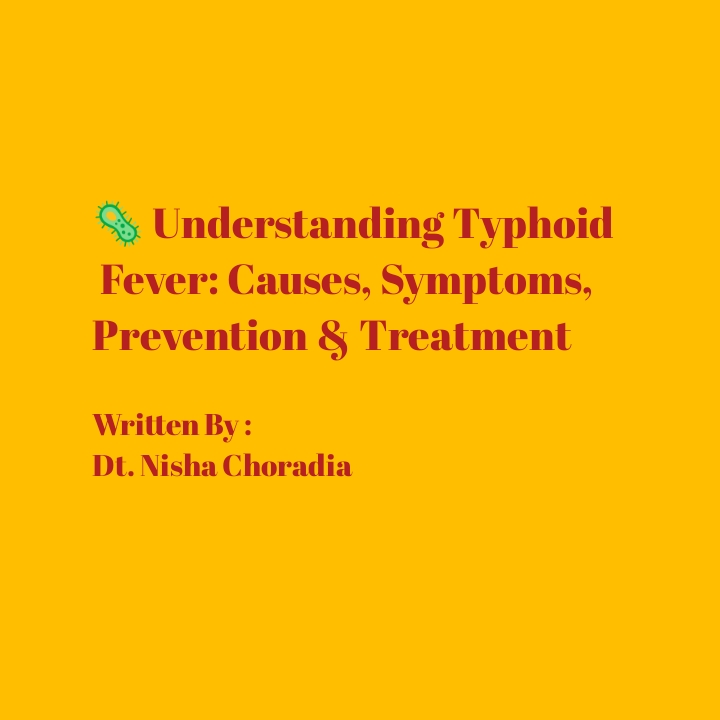Understanding Typhoid Fever: Causes, Symptoms, Prevention & Treatment
Typhoid fever remains a significant public health concern, particularly in regions with limited access to clean water and adequate sanitation. Despite being preventable and treatable, it continues to affect millions worldwide, often with serious health consequences if not promptly addressed.
In this blog post, I will explore what typhoid fever is, its causes, common symptoms, preventive strategies, and current treatment options.
What is Typhoid Fever?
Typhoid fever is a bacterial infection caused by Salmonella enterica serotype Typhi. It spreads primarily through the ingestion of contaminated food or water, making it especially prevalent in areas where water purification and sewage disposal systems are inadequate.
According to the World Health Organization (WHO)**, there are an estimated 11–20 million cases of typhoid fever globally each year, resulting in about 128,000 to 161,000 deaths.
Causes & Transmission
The infection is spread through the fecal-oral route, meaning a person can contract the disease by consuming food or beverages handled by someone shedding S.Typhi bacteria, or by drinking water contaminated with sewage.
Common risk factors include:
- Consuming unwashed or raw food
- Drinking untreated or contaminated water
- Living in or traveling to endemic regions
- Poor hand hygiene or sanitation practices
It’s important to note that only humans carry S. Typhi—there are no animal reservoirs—making human hygiene and public sanitation key factors in disease control.
Recognizing the Symptoms
Typhoid fever has an incubation period of 6 to 30 days after exposure. Symptoms can vary from mild to severe and may progress gradually.
Typical signs and symptoms:
- High, sustained fever (can reach up to 104°F or 40°C)
- Weakness and fatigue
- Headache
- Stomach pain and discomfort
- Constipation or diarrhea
- Loss of appetite
- Dry cough
In some cases, patients may develop:
- Rose-colored spots on the trunk or chest
- Enlarged liver or spleen
- Mental confusion or delirium
- Severe intestinal complications such as perforation or bleeding
If left untreated, typhoid fever can become life-threatening, especially in vulnerable populations like children or the immunocompromised.
Prevention: Stay Ahead of the Disease
1. Vaccination
Vaccination is highly recommended, especially for individuals traveling to endemic regions. There are two main types of typhoid vaccines:
- Typhoid Conjugate Vaccine (TCV): Injectable; suitable for children as young as 6 months.
- Live Attenuated Oral Vaccine (Ty21a):** Taken in capsule form over several days; not suitable for very young children.
2. Food and Water Safety
- Drink only **boiled or bottled water**
- Avoid raw fruits and vegetables unless you can peel them yourself
- Do not consume food from unregulated street vendors
- Be cautious with ice, as it may be made from contaminated water
3. Good Hygiene Practices
- Wash hands thoroughly with soap and water before eating or preparing food
- Encourage proper sanitation in communities
- Educate about the importance of safe food handling and clean water.
Diagnosis & Treatment
Diagnosis:
Typhoid fever is diagnosed through blood, stool, or bone marrow cultures, with blood culture being the most commonly used test in clinical settings.
Treatment:
Early treatment is crucial and significantly reduces the risk of complication
First-line antibiotics include:
- Ciprofloxacin– commonly used in areas without resistance
- Azithromycin – effective for uncomplicated cases
- Ceftriaxone – often used for drug-resistant strains
Due to increasing antibiotic resistance, particularly in South Asia and parts of Africa, treatment plans may vary depending on local resistance patterns.
Supportive care may include:
- Hydration therapy
- Nutritional support
- Fever management
Hospitalization is recommended for severe or complicated cases, especially if intestinal perforation or sepsis is suspected.
Carrier State & Public Health Implications
A small percentage of individuals who recover from typhoid become chronic carriers, shedding the bacteria in their stool for years without symptoms. These individuals can continue to infect others unknowingly, which poses a significant public health challenge.
Proper antibiotic treatment, follow-up testing, and in some cases, longer-term medication are necessary to eliminate the carrier state
Typhoid fever is both preventable and treatable, yet it continues to cause illness and death in many parts of the world. With improved access to vaccines, clean water, safe food, and health education, the global burden of typhoid can be significantly reduced.
If you’re planning to travel to a high-risk area or live in a region where typhoid is common, talk to your healthcare provider about preventive steps, including vaccination and safe practices.
- Stay informed. Stay protected. Health begins with awareness.
Written By
Dt.Nisha Choradia
29 September 2025





